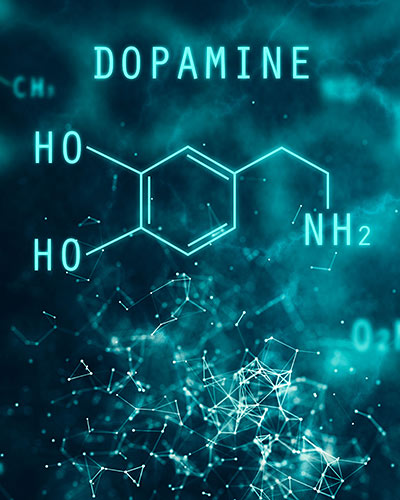April 20, 2018 | David Kohn

University Of Maryland School of Medicine Scientists Identify Connection between Dopamine and Behavior Related to Pain and Fear
Scientists at the University of Maryland School of Medicine have for the first time found direct causal links between a key brain chemical and avoidance-behavior related to pain and fear.
Researchers have long known that the neurotransmitter dopamine plays a key role in driving behavior related to pleasurable goals, such as food, sex and social interaction. In general, increasing dopamine boosts the drive toward these stimuli. But dopamine’s role in allowing organisms to avoid negative events has remained mysterious.
The new study establishes for the first time that dopamine is central in causing behavior related to the avoidance of specific threats. The work was published today in the journal Current Biology.
“This study significantly advances what we know about how dopamine affects aversively motivated behaviors,” said Joseph F. Cheer PhD, a professor in the UMSOM Department of Anatomy & Neurobiology and the study’s corresponding author. “In the past, we thought of dopamine as a neurotransmitter involved in actions associated with the pursuit of rewards. With this new information we can delve into how dopamine affects so many more kinds of motivated behavior.”
To better understand the role that dopamine plays in this process, Dr. Cheer and his colleagues, including principal author Jennifer Wenzel, PhD, a fellow in Dr. Cheer’s laboratory, studied rats, focusing on a particular brain area, the nucleus accumbens. This brain region plays a crucial role in linking the need or desire for a given reward – food, sex, etc. – with the motor response to actually obtain that reward.
To study the animals under natural conditions, they used optogenetics, a relatively new technique in which specific groups of neurons can be controlled by exposure to light. In this case, Dr. Cheer’s group used a blue laser to stimulate genetically modified rats whose dopamine neurons could be controlled to send out more or less dopamine. In this way, they were able to see how dopamine levels affected the animals’ behavior. The principal advantage of this approach: he could control dopamine levels even as the animals moved freely in their environment.

Dr. Cheer says that this indicates that dopamine causally drives animals to avoid unpleasant or painful situations and stimuli. The results greatly expand the role that dopamine plays in driving behavior.
The researchers also examined the role that endocannabinoids play in this process. Endocannabinoids, brain chemicals that resemble the active ingredients in marijuana, play key roles in many brain processes. Here, Dr. Cheer and his colleagues found that endocannabinoids essentially open the gate that allows the dopamine neurons to fire. When the researchers reduced the level of endocannabinoids, the animals were much less likely to move to avoid shocks.
Dr. Cheer argues that the research sheds light on brain disorders such as post-traumatic stress disorder and depression. In depression, patients feel unable to avoid a sense of helplessness in the face of problems, and tend to ruminate rather than act to improve their situation. In PTSD, patients are unable to avoid an overwhelming sense of fear and anxiety in the face of seemingly low-stress situations. Both disorders, he says, may involve abnormally low levels of dopamine, and may be seen on some level as a failure of the avoidance system.
In both depression and PTSD, doctors already sometimes treat patients with medicine to increase dopamine and there are now clinical trials testing use of endocannabinoid drugs to treat these conditions. Dr. Cheer suggests that this approach may need to be used more often, and should certainly be studied in more detail.
“Using optogenetics to understand the brain is quite revolutionary,” said E. Albert Reece, MD, PhD, MBA, Executive Vice President for Medical Affairs at UM Baltimore, and the John Z. and Akiko K. Bowers Distinguished Professor and Dean, University of Maryland School of Medicine. “This research holds the potential to elucidate questions that we have long wanted to answer about human behavior and human mood disorders. It is not only fascinating on a scientific level, it has potentially powerful clinical implications.”
About the University of Maryland School of Medicine
Commemorating its 210th Anniversary, the University of Maryland School of Medicine was chartered in 1807 as the first public medical school in the United States. It continues today as one of the fastest growing, top-tier biomedical research enterprises in the world -- with 43 academic departments, centers, institutes, and programs; and a faculty of more than 3,000 physicians, scientists, and allied health professionals, including members of the National Academy of Medicine and the National Academy of Sciences, and a distinguished recipient of the Albert E. Lasker Award in Medical Research. With an operating budget of more than $1 billion, the School of Medicine works closely in partnership with the University of Maryland Medical Center and Medical System to provide research-intensive, academic and clinically-based care for more than 1.2 million patients each year. The School has over 2,500 students, residents, and fellows, and nearly $450 million in extramural funding, with most of its academic departments highly ranked among all medical schools in the nation in research funding. As one of the seven professional schools that make up the University of Maryland Baltimore campus, the School of Medicine has a total workforce of nearly 7,000 individuals. The combined School and Medical System (“University of Maryland Medicine”) has an annual budget of nearly $6 billion and an economic impact in excess of $15 billion on the state and local community. The School of Medicine faculty, which ranks as the 8th-highest public medical school in research productivity, is an innovator in translational medicine, with 600 active patents and 24 start-up companies. The School works locally, nationally, and globally, with research and treatment facilities in 36 countries around the world. Visit medschool.umaryland.edu/
Contact
Office of Public Affairs
655 West Baltimore Street
Bressler Research Building 14-002
Baltimore, Maryland 21201-1559
Contact Media Relations
(410) 706-5260
Related stories

Tuesday, February 09, 2021
UM School of Medicine Researchers Find that Misuse of Opioid Drugs During Pregnancy Could Have Lasting Impact on Child’s Development from Infancy Through Teen Years
As the number of pregnant women using opioid drugs continues to rise, questions have been raised about the long-term health effects on children exposed to these drugs in the womb. Researchers at the University of Maryland School of Medicine now have preliminary but striking evidence that suggests that such exposure can cause long-lasting impairment in the brain’s ability to process sensory information. These impairments may give rise to autism, attention deficit hyperactivity disorder, and substance use disorders during adolescence. The landmark study, recently published in Journal of Neuroscience, used a preclinical model to study the issue and found that newborn mice exposed to the opioid fentanyl in the womb developed withdrawal symptoms and sensory processing disorders that lasted at least until adolescence.

Thursday, April 16, 2020
University of Maryland School of Medicine Launches Center for Substance Use in Pregnancy
Asaf Keller, PhD, Professor and Interim Chair of the Department of Anatomy & Neurobiology at the University of Maryland School of Medicine (UMSOM), along with UMSOM Dean E. Albert Reece, MD, PhD, MBA, have announced the formation of a new research center to study the long-term health effects on the brains of children born to women who use drugs and alcohol during pregnancy. The Center for Substance Use in Pregnancy will conduct pre-clinical and clinical neuroscience research, focusing on the use of marijuana, opioids, nicotine and alcohol, all of which have increased dramatically in recent years.

Wednesday, October 16, 2019
Researchers Discover Potential Therapy to Treat Detrimental Effects of Marijuana in Pre-Adolescent Individuals Exposed to THC in Womb
As a growing number of U.S. states legalize the medicinal and recreational use of marijuana, an increasing number of American women are using cannabis before becoming pregnant and during early pregnancy often to treat morning sickness, anxiety, and lower back pain. Although emerging evidence indicates that this may have long-term consequences for their babies’ brain development, how this occurs remains unclear.
